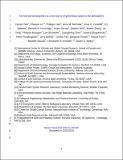| dc.contributor.author | Tian, Hanqin | |
| dc.contributor.author | Lu, Chaoqun | |
| dc.contributor.author | Ciais, Philippe | |
| dc.contributor.author | Michalak, Anna M. | |
| dc.contributor.author | Canadell, Josep G. | |
| dc.contributor.author | Saikawa, Eri | |
| dc.contributor.author | Huntzinger, Deborah N. | |
| dc.contributor.author | Gurney, Kevin R. | |
| dc.contributor.author | Sitch, Stephen | |
| dc.contributor.author | Zhang, Bowen | |
| dc.contributor.author | Yang, Jia | |
| dc.contributor.author | Bousquet, Philippe | |
| dc.contributor.author | Bruhwiler, Lori | |
| dc.contributor.author | Chen, Guangsheng | |
| dc.contributor.author | Dlugokencky, Edward | |
| dc.contributor.author | Friedlingstein, Pierre | |
| dc.contributor.author | Melillo, Jerry | |
| dc.contributor.author | Pan, Shufen | |
| dc.contributor.author | Poulter, Benjamin | |
| dc.contributor.author | Saunois, Marielle | |
| dc.contributor.author | Schwalm, Christopher R. | |
| dc.contributor.author | Wofsy, Steven C. | |
| dc.contributor.author | Prinn, Ronald G | |
| dc.date.accessioned | 2016-11-08T19:01:44Z | |
| dc.date.available | 2016-11-08T19:01:44Z | |
| dc.date.issued | 2016-03 | |
| dc.date.submitted | 2015-01 | |
| dc.identifier.issn | 0028-0836 | |
| dc.identifier.issn | 1476-4687 | |
| dc.identifier.uri | http://hdl.handle.net/1721.1/105264 | |
| dc.description.abstract | The terrestrial biosphere can release or absorb the greenhouse gases, carbon dioxide (CO[subscript 2]), methane (CH[subscript 4]) and nitrous oxide (N[subscript 2]O), and therefore has an important role in regulating atmospheric composition and climate. Anthropogenic activities such as land-use change, agriculture and waste management have altered terrestrial biogenic greenhouse gas fluxes, and the resulting increases in methane and nitrous oxide emissions in particular can contribute to climate change. The terrestrial biogenic fluxes of individual greenhouse gases have been studied extensively,but the net biogenic greenhouse gas balance resulting from anthropogenic activities and its effect on the climate system remains uncertain. Here we use bottom-up (inventory, statistical extrapolation of local flux measurements, and process-based modelling) and top-down (atmospheric inversions) approaches to quantify the global net biogenic greenhouse gas balance between 1981 and 2010 resulting from anthropogenic activities and its effect on the climate system. We find that the cumulative warming capacity of concurrent biogenic methane and nitrous oxide emissions is a factor of about two larger than the cooling effect resulting from the global land carbon dioxide uptake from 2001 to 2010. This results in a net positive cumulative impact of the three greenhouse gases on the planetary energy budget, with a best estimate (in petagrams of CO[subscript 2] equivalent per year) of 3.9 ± 3.8 (top down) and 5.4 ± 4.8 (bottom up) based on the GWP100 metric (global warming potential on a 100-year time horizon). Our findings suggest that a reduction in agricultural methane and nitrous oxide emissions, particularly in Southern Asia, may help mitigate climate change. | en_US |
| dc.description.sponsorship | United States. National Aeronautics and Space Administration (NASA Grant NNX08AL73G) | en_US |
| dc.description.sponsorship | United States. National Aeronautics and Space Administration (NASA Grant NNX14AO73G) | en_US |
| dc.description.sponsorship | United States. National Aeronautics and Space Administration (NASA Grant NNX10AU06G) | en_US |
| dc.description.sponsorship | United States. National Aeronautics and Space Administration (NASA Grant NNX11AD47G) | en_US |
| dc.description.sponsorship | United States. National Aeronautics and Space Administration (NASA Grant NNG04GM39C) | en_US |
| dc.description.sponsorship | National Science Foundation (U.S.) (NSF grant AGS 1243232) | en_US |
| dc.description.sponsorship | National Science Foundation (U.S.) (Grant AGS-1243220) | en_US |
| dc.description.sponsorship | National Science Foundation (U.S.) (NSF grant CNH1210360) | en_US |
| dc.description.sponsorship | United States. National Oceanic and Atmospheric Administration (NOAA Climate Program Office award NA13OAR4310059) | en_US |
| dc.description.sponsorship | Australian Climate Change Science Programme | en_US |
| dc.description.sponsorship | National Science Foundation (U.S.) (NSF CAREER (AGS-0846358)) | en_US |
| dc.description.sponsorship | United States. National Aeronautics and Space Administration (NASA Upper Atmosphere Research Program AGAGE, grant NNX11AF17G) | en_US |
| dc.language.iso | en_US | |
| dc.publisher | Springer Nature | en_US |
| dc.relation.isversionof | http://dx.doi.org/10.1038/nature16946 | en_US |
| dc.rights | Creative Commons Attribution-Noncommercial-Share Alike | en_US |
| dc.rights.uri | http://creativecommons.org/licenses/by-nc-sa/4.0/ | en_US |
| dc.source | Prof. Prinn | en_US |
| dc.title | The terrestrial biosphere as a net source of greenhouse gases to the atmosphere | en_US |
| dc.type | Article | en_US |
| dc.identifier.citation | Tian, Hanqin, Chaoqun Lu, Philippe Ciais, Anna M. Michalak, Josep G. Canadell, Eri Saikawa, Deborah N. Huntzinger, et al. “The Terrestrial Biosphere as a Net Source of Greenhouse Gases to the Atmosphere.” Nature 531, no. 7593 (March 9, 2016): 225–228. | en_US |
| dc.contributor.department | Massachusetts Institute of Technology. Center for Global Change Science | en_US |
| dc.contributor.department | Massachusetts Institute of Technology. Department of Earth, Atmospheric, and Planetary Sciences | en_US |
| dc.contributor.mitauthor | Prinn, Ronald G | |
| dc.relation.journal | Nature | en_US |
| dc.eprint.version | Author's final manuscript | en_US |
| dc.type.uri | http://purl.org/eprint/type/JournalArticle | en_US |
| eprint.status | http://purl.org/eprint/status/PeerReviewed | en_US |
| dspace.orderedauthors | Tian, Hanqin; Lu, Chaoqun; Ciais, Philippe; Michalak, Anna M.; Canadell, Josep G.; Saikawa, Eri; Huntzinger, Deborah N.; Gurney, Kevin R.; Sitch, Stephen; Zhang, Bowen; Yang, Jia; Bousquet, Philippe; Bruhwiler, Lori; Chen, Guangsheng; Dlugokencky, Edward; Friedlingstein, Pierre; Melillo, Jerry; Pan, Shufen; Poulter, Benjamin; Prinn, Ronald; Saunois, Marielle; Schwalm, Christopher R.; Wofsy, Steven C. | en_US |
| dspace.embargo.terms | N | en_US |
| dc.identifier.orcid | https://orcid.org/0000-0001-5925-3801 | |
| mit.license | OPEN_ACCESS_POLICY | en_US |
